- How to create, edit, and delete asset
- Asset details
- Manage asset owner and groups
- Share asset
- Make asset group public
- Share asset group
- Managing asset relations. How to add, view, edit, delete
Asset is an abstract entity in the IoT system of ThingsBoard that represents any physical object, space, or organizational unit. Examples include a building, room, production area, field, streetlight, substation, or vehicle.
Key characteristics of an asset:
- Does not generate telemetry on its own but can be associated with devices that do.
- Can have its own attributes, such as location, type, or responsible personnel.
- Used for grouping devices and other entities.
- Can be part of a hierarchy, e.g., Substation ⟶ Line ⟶ Streetlight.
- Participates in ThingsBoard business logic, such as rule chains, alarms, and dashboards.
Assets help logically and efficiently structure your IoT project, making it easier to manage and scale.
ThingsBoard supports asset management functions via both the web UI and the REST API.
Practical video course 🎥
Watch this practical video course to learn how to configure and manage ThingsBoard dashboards, resources, and devices, and how to use them in real-world scenarios.
How to create, edit, and delete asset
Tenant administrators and users with appropriate permissions can create, edit, or delete assets in ThingsBoard.
Creating asset
To create a new asset:
- Navigate to Entities ⟶ Assets. By default, you will see the “All” asset group.
- Click the “+” icon in the upper-right corner and select “Add new asset” from drop-down menu.
- In the asset creation form, fill in the required fields:
- Name – a unique name for the asset.
-
Asset profile – by default, the profile is set to “default”, but you can choose a different profile if needed.
- Owner and groups: Helps with organization and access control.
- Owner: Select the owner from the dropdown list. The asset will be created at that owner’s level. By default, the field is pre-filled with the Customer or Tenant name based on where you add the asset. You can change it before confirming adding.
- Groups: Optional field. Add the asset to existing asset groups or create a new one at the selected owner level. Note: every asset is automatically added to the “All” group of that owner.
- Optional fields such as Label or Description can be filled in if needed.
- Click “Add”.
The asset has been successfully created and is now available in the list.

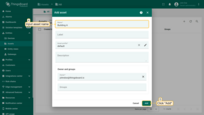

Creating asset group
Assets can belong to one or multiple groups, which helps organize and manage them effectively.
To create a new asset group:
- From the Assets screen, go to the “Group” tab.
- Click the “+” icon in the upper-right corner.
- Enter the name of the new asset group.
- (Optional) Configure shared access to this group for your customers, if needed.
- Click “Add” to create the group.
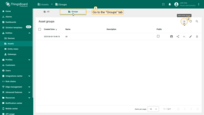
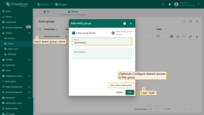

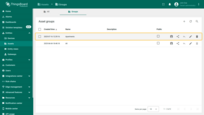
Managing asset groups. How to add, move, remove
From the Assets page, you can add assets to groups, move them between groups, or remove them from a group.
The “All” asset group always contains all assets at the selected owner level (Tenant or Customer).
Add a single asset to groups:
- Open the asset details ➜ click Manage owner and groups.
- In the dialog, adjust Owner if necessary and select groups to add or remove the asset from.
- Click Save.
Add multiple assets to one group:
- On the Groups tab, open any asset group (e.g., “All”).
- Select assets using the checkboxes (on the left of their names).
- Click the “Add to group” (plus-in-circle icon) in the top-right.
- In Add to group window, choose Select existing entity group or Create new entity group.
- Select an existing or create a new asset group.
- Click Add to confirm adding the assets to the group.
Move assets to another group:
- Open a specific (non-All) group.
- Select assets and click Move to group (two-arrow icon).
- In “Move to group” window, choose Select existing entity group or Create new entity group.
- Select an existing or create a new asset group.
- Click Move to confirm.
This action removes assets from the current group and adds them to the selected group.
Remove assets from a group:
- Open a specific (non-All) group.
- Select assets and click Remove from group (minus-in-circle icon) in the top-right.
- Confirm removal.
Editing asset
To edit an existing asset:
- In the Assets list, locate and click on the desired asset.
- Click the “pencil” (✏️ Edit) icon on the right.
- In the edit window, you can modify the following fields:
- Name
- Label
- Asset profile
- Description
- After making the necessary changes, click “Apply changes” to save.

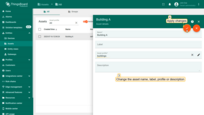
Deleting asset
To delete an asset or asset group:
- Find the item in the list and click the "trash bin" icon next to it.
- Confirm the deletion in the popup dialog.
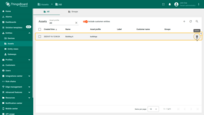
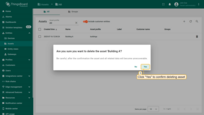
Note: Deleting an asset does not delete the devices or other entities linked to it, but it will break all existing relations (such as links to devices, alarms, dashboards, etc.).
Asset details
Clicking on an asset opens a window where you can access and manage various aspects of that asset:
- Copy the asset Id to the clipboard using the “Copy asset Id” button.
- Manage server-side attributes of the asset.
- Perform additional computations on telemetry and attributes using the Calculated fields feature.
- View current and historical alarms of the asset.
- Browse asset-related events, such as errors, warnings, and other key lifecycle moments.
- Manage relations between this asset and other entities, such as devices, dashboards, etc.
- Track user actions and changes related to the asset in the Audit log.
- Use the ThingsBoard Version control system to export and restore the asset as part of Git-based object management.
Manage asset owner and groups
You can change the owner of an asset. This ensures that only users associated with the selected customer will have access to the asset and its data.
This step is essential for maintaining strict data access control. Each customer user will only see their own assigned assets and will not have visibility into assets or data belonging to other customers.
To change asset owner:
- Click the asset to open its Asset details.
- Click the “Manage owner and groups” button.
- In the Owner field, select Tenant or a specific Customer.
- Add the asset to the relevant asset groups or create a new group if needed.
- Click “Update” to confirm and apply the changes.
In the “Customer name” column, you can see the current owner of the asset.
A Tenant Administrator always has the right to reassign or revoke asset ownership.
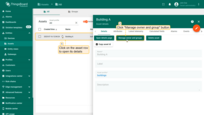
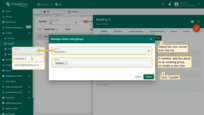
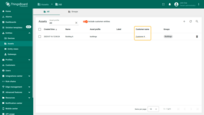
Include customer entities
The “Include customer entities” option on the “Assets” page determines whether assets owned by customers are shown or hidden in the list.
- When the switch is enabled (default state) – the table shows all available assets, including those owned by customers.
- When the switch is disabled – the table shows only your own assets, excluding customer-owned assets.
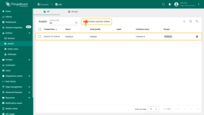
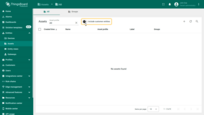
Share asset
You can share assets by adding them to an asset group and then sharing the group with a customer.
For detailed instructions, please see the section on how to Share asset group.
Make asset group public
You can make an asset group public to ensure that all data within it is accessible to everyone. This is ideal for:
- Creating public demo dashboards that require access to asset data.
- Supporting open data use cases.
You cannot share an individual asset directly — only the asset group that contains it.
To make an asset group public:
- Locate the desired asset group in the list.
- Click the “Make public” icon next to it.
- Confirm your action in the popup dialog.
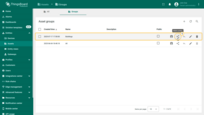
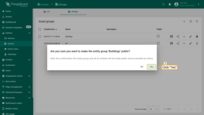
Once public, any dashboards or external systems referencing assets in this group will have access without requiring authentication.
To make the group private again, follow the same steps using the “Make private” icon.


Share asset group
You can share an asset group with one or more customers. This is useful, for example, when multiple customers need access to the same asset.
You cannot share an individual asset — only the asset group that contains it.
To share an asset group:
- Locate the desired asset group in the list.
- Click the “Share” icon next to it.
- Select the target customer from the dropdown list.
- (Optional) Specify the user group within that customer to share the asset group with.
- Confirm the action by clicking “Share”.

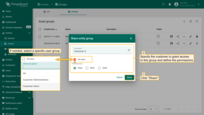
Managing and Verifying Permissions
After an asset group has been shared, you can view, edit, or revoke permissions at any time.
-
From the “Asset groups” list, click on the “pencil” button of the desired group to open the “Entity group details”.
-
Navigate to the Permissions tab.
-
On this tab, you will see a complete list of all permissions granted for this group. Here you can:
-
Add a new permission: Click the “+” icon in the top right corner of the panel. A dialog window will appear where you can select a role and a user group to grant access to.
-
Edit an existing permission: Click the “pencil” icon next to the permission you want to modify.
-
Delete a permission: Click the “trash can” icon to remove access for that user group.
Managing asset relations. How to add, view, edit, delete
From the Assets page, you can create, view, edit, and delete relations between an asset and other entities (assets, devices, customers, etc.). See details about Entities and relations.
To manage relations between an asset and other entities for a specific asset:
- Open the asset details ➜ go to the Relations tab.
Add a new relation:
- In the Direction selector, choose From (outbound) or To (inbound).
- Click “+” icon (Add).
- In Add relation window, set Relation type (e.g., Contains, Manages) and choose the To entity (Entity type and target entities).
- Click Add to confirm.
View & filter relations:
- Switch Direction between “From” and “To” to see outbound/inbound relations.
- Use the search icon to filter by relation type or entity.
Edit a relation:
- In the list, click the “pencil” icon to change the relation type or target entity, then Save.
Delete a relation:
- Click the “trash can” icon next to a relation and confirm deleting.